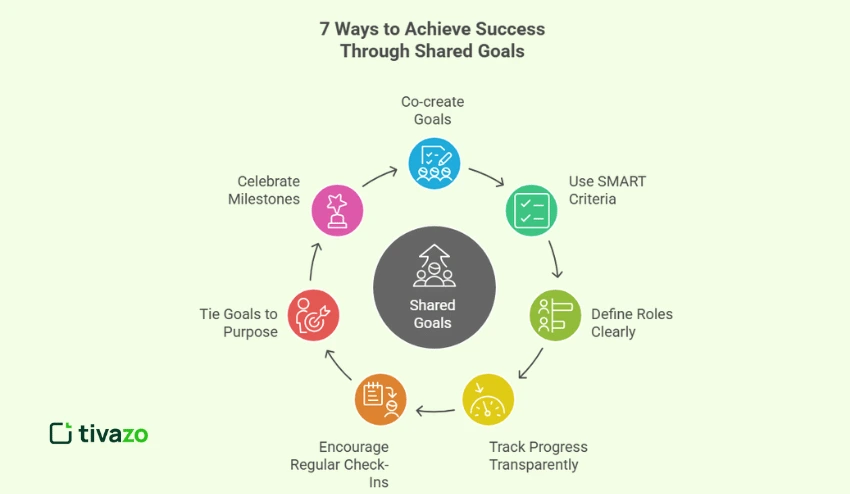It is like a team where all the members are moving in a common direction with a common mission. When shared goals are crystal clear, that synergy becomes a reality, and success is a natural consequence.
In the current hybrid and cross-functional work environment, it is not an option to have several teams unite around a single shared goals, but a necessity. Common objectives provide clarity, enhance alignment within teams, and create the interdependence characteristic of high performance.
When a team becomes cohesive with regard to the goals, they will access a greater level of motivation, team synergy, and a sense of purpose. Instead of people pursuing different goals, all people are involved in developing and owning common goals. This contributes to improved communications, less silo, and the ability to carry out the collective mission more effectively. This blog will give you an understanding of what shared goals are, why they are important, and how to succeed using these shared goals in seven tried-and-true methods.
Key Highlights:
- Importance Of Shared Goals
- 7 Ways to Achieve Success Through Shared Goals
- Shared Goals in the Workplace
- Shared Goals in Business
- How Tivazo Helps You and Your Team to Achieve Shared Goals
What Are Shared Goals?
Shared goals are goals that are agreed upon to be achieved by a group or an organization and are aimed at making each member work towards the same desired aim. The uniqueness of shared goals compared to individual KPIs is that it facilitates team alignment, shared accountability, and a clear, mutually shared vision. They are used as a unifying strategy that informs decision-making, motivates group goals, and enhances team synergy. Shared goals, when well articulated, minimize misunderstanding, maximize collaboration, and concentrate efforts on the accomplishment of a common mission. Shared goals can be used to enable teams to overcome silos, enhance productivity, and develop better relationships at the workplace, which are the ingredients of long-term success in any business context.
Importance Of Shared Goals
Having shared goals is critical to creating successful teams and is the anchor that can guide the efforts and determine what is important. Shared goals eliminate confusion, build morale, and focus among team members due to the alignment of team goals and the sharing of the vision. They promote positive interdependence, i.e., when one of the people succeeds, the whole group is promoted. This shared commitment reinforces the goals of collaboration, enhances communication, and facilitates long-term performance.
Besides, common objectives aid in dismantling organizational silos, which leads to enhanced team synergy and accountability. When the teams are able to grasp and appreciate common objectives, they will be more unified and flexible, and thus capable of responding to challenges and changes. This cohesion not only makes the work more productive, but it also makes the employees more engaged and satisfied with their work because it makes it more meaningful.
Studies indicate that organizations that have well-communicated shared goals have higher retention rates and overall performance. When teams are united by a common goal, they will be more willing to innovate, collaborate, and achieve outstanding performance. In the current competitive business world, the value of common interests can hardly be overestimated, as it is the key to achieving sustainable success and long-term development.
7 Ways to Achieve Success Through Shared Goals
To make shared goals work, they must be defined, communicated, and embraced by the team. Here are seven proven strategies to harness their power.

1. Co-create Goals Together
Instead of top-down dictates, engage the team players in the process of setting the objectives. Goal-setting is collaborative and makes everyone feel a part of it.
This method fosters shared vision and enhances cohesion in the team. When individuals are involved in defining the course, they are more concerned with the result.
When you make a list of tasks together and turn them into a list of shared goals, you make the list a purpose that everyone supports and champions.
2. Use SMART Criteria
Make your common objectives Specific, Measurable, Achievable, Relevant, and Time-bound. SMART goals limit ambiguity, enhance tracking, and enhance motivation.
They provide clarity, which increases individual accountability as well as synergy. Without this framework, mutual objectives may just turn out to be ambiguous or erratic.
SMART goals lead to improvement, consistency of expectations, and the formation of actionable plans of execution.
3. Define Roles Clearly
Appoint people to the positions where they have strengths. The existence of specific roles within a team prevents duplication and makes an organization run more efficiently.
Such transparency aids in team goals and makes each individual aware of how his/her efforts relate to the group goals. It also helps in building confidence and minimizing friction.
Role clarity helps in making shared goals more specific to implementation.
4. Track Progress Transparently
Consider dashboards or other basic tracking devices that will enable everyone to see progress. Accountability and keeping shared goals at the forefront are achieved through transparent tracking.

It can also reveal problems early, and it can also celebrate small victories in the process. Transparency instills a culture of openness and accountability among each other.
Monitoring of common objectives on a regular basis will provide a constant focus and energy at all levels of the team.
5. Encourage Regular Check-Ins
The reviews can be done weekly or every two weeks to keep everyone on the same page and adjust goals as necessary. Such check-ins maintain the flow of communication and expectations.
They also allow room to give feedback, clarify, and cooperate, and this supports the commonality of the objectives.
Regular check-ins help teams get on the same page and minimize the chances of uncoordinated efforts or stalling.
6. Tie Goals to Superordinate Purpose
Everyday tasks are linked to a bigger picture or value in the long run. This may be sustainability, customer impact, or innovation.
Purpose-driven objectives appeal to emotion and group identity, building more commitment and greater motivation.
When teams have a shared mission, they will go further together.
7. Celebrate Milestones Together
When the team has a collective achievement, make it a team win. Recognition strengthens culture and trust and encourages further development.
The celebrations of a group, even a small group, strengthen the sense of togetherness and success.
Noting achievements demonstrates that shared objectives are more than a to-do list; they are part of a larger process.
When teams implement these practices, they no longer just share goals, but they embody them, align through them, and deliver through the efforts of their collective work.
Shared Goals in the Workplace
In the workplace environment, common objectives change the way organizations work across departments and disciplines. By setting cooperative goals that are clear to all, organizations decrease both miscommunication and functional silos. When the team members understand how their individual efforts roll up to the common objectives, they feel more accountable to one another, have better team alignment, and have a clear sense of shared mission.
Notably, common objectives promote flexibility: workers will be more ready to go beyond their job specifications to help the team succeed. The outcome is an increase in cross-functional cooperation, efficiency, and team cohesion. Common objectives also contribute to the establishment of a feedback culture—open communication is the rule of the game since all know what they are working to achieve. Mental empathy increases, teams are not afraid to speak up, and performance is enhanced.
Shared Goals in Business
In business areas, the alignment of departments through common objectives, direction of the company, and a healthy performance culture is achieved. By having clear communication of common goals, stakeholder alignment is achieved, a common vision is created, and all teams are working towards the greater picture.
Common business objectives promote openness, responsibility, and teamwork among formerly separated teams. When sales, marketing, operations, and product work together, they can all operate in harmony when they are united around common goals. This enhances not only the execution but also speeds up innovation and responsiveness in competitive markets.
When decision-making is informed by shared goals, there is increased strategic focus, enhanced resource utilization, and employee engagement in the companies. Whether climbing a startup or managing a company team, basing the decision-making process on shared objectives will result in more stable outcomes and long-term success.
How Tivazo Helps You and Your Team to Achieve Shared Goals
Tivazo also enables teams to be oriented towards common objectives by providing real-time visibility, role-based access, and performance dashboards, which foster team alignment and accountability. Real-time screenshots and productivity heatmaps are available, which promote trust in the process by showing who is working and when.

Under Tivazo, with centralized time tracking, task assignment, and reporting, managers can relate individual tasks to the greater goals of collaboration. That way, each hour is dedicated to common objectives and mission accomplishment within remote or office-based groups.
Conclusion
The pillar of collaborative success is shared goals. When teams co-create, track, and celebrate them collectively, they open up to new levels of trust, alignment, and performance. When you create shared goals into the DNA of your team and use tools like Tivazo to stay accountable, you are preconditioning growth and synergy in the long term.
So, are you ready to lead your team to success by having a common goal?




